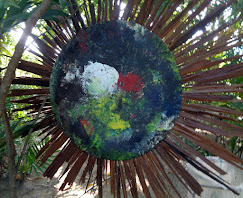A Visit to an Art Gallery Series 5
Naturalism in Paintings
By Dr Abe V Rotor
Scenic imagery of an unspoiled landscape, mural on canvas,
Dasmariñas Village residence, MM. AVR
“All good things are wild, and free.” - Henry David Thoreau
Section of a wall mural at author's residence QC. AVR
La Union Botanical Garden, on-the spot painting
San Fernando, LU. AVR
"Hunting, fishing, drawing, and music occupied my every moment.
Cares I knew not, and cared naught about them.” - John Muir
Adventure by a waterfall, imaginary scene,
likened to Pinsal Falls, Sta Maria, Ilocos Sur. AVR
“Many men go fishing all of their lives without knowing that it is not fish they are after.” - Henry David Thoreau
“
Raging Falls after heavy downpour in acrylic on wood. AVR
The earth and its resources belong of right to its people.” -
Gifford Pinchot
Parakeets and Butterflies, detail of a canvas painting. AVR
“A true conservationist is a man who knows
that the world is not given by his father,
but borrowed from his children.”
- John James Audubon
Sea cavern dwellers wake to the morning sun. AVR
“Conservation means the wise use of the earth and its resources for the lasting good of men.” - Gifford Pinchot“
Seagrass blue and red fishes, glass painting AVR
The price of anything is the amount of life you exchange for it.”
- Henry David Thoreau
Red coral fish, glass painting AVR
When one tugs at a single thing in nature,
he finds it attached to the rest of the world.” - John Muir
Hybrid Flowers, glass painting AVR ~
“There are no words that can tell the hidden spirit of the wilderness,
that can reveal its mystery, its melancholy and its charm.”
- Theodore Roosevelt
------------------------
The aforementioned quotations came from America's foremost naturalists: Theodore Roosevelt, Henry David Thoreau,- John James Audubon, John Muir, and Gifford Pinchot.






























.jpg)



























